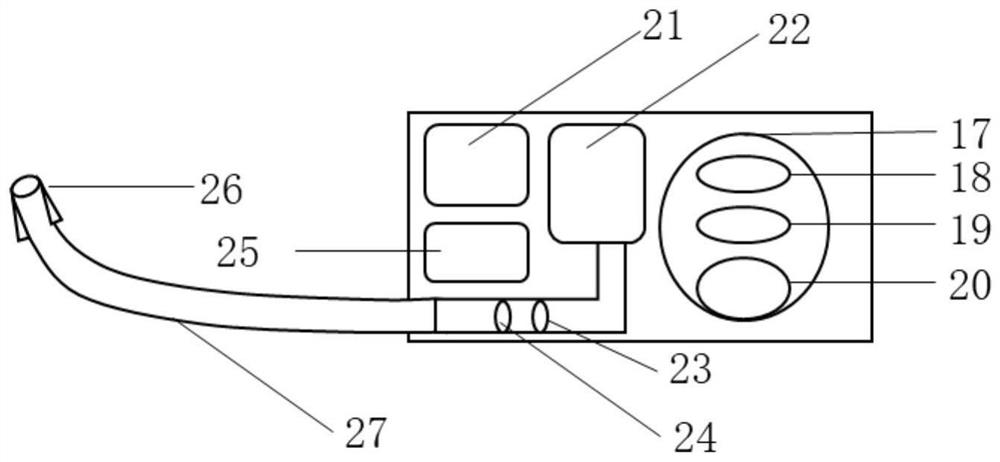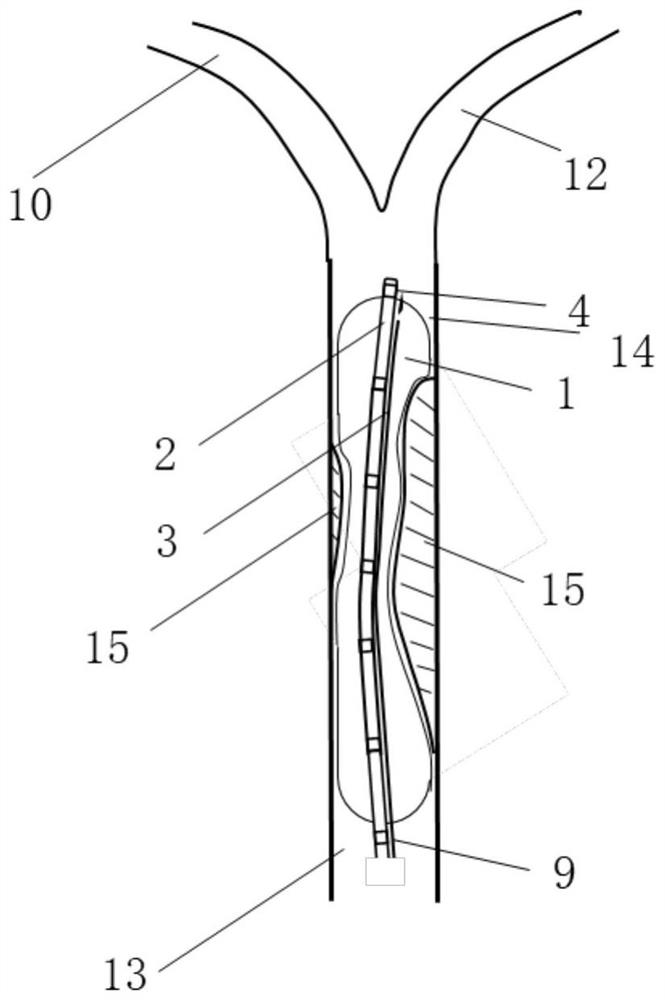Cylindrical optical fiber balloon catheter device for biliary tract tumor photodynamic precise treatment
A fiber optic catheter and balloon catheter technology, applied in the field of medical devices, can solve problems such as inaccurate positioning, uneven irradiation of columnar optical fibers, etc., and achieve the effect of improving the effect
- Summary
- Abstract
- Description
- Claims
- Application Information
AI Technical Summary
Problems solved by technology
Method used
Image
Examples
Embodiment 1
[0050] For patients with distal cholangiocarcinoma and hilar cholangiocarcinoma Bismuth-Corlett type I, the matching device of the present invention is selected according to the length of the lesion and placed in the common bile duct 13 or the common hepatic duct 14, the inflatable balloon 1 spans the longest tumor 15 And both ends exceed 0.5-1cm to ensure the scope of treatment. The quantitative inflation device 16 is connected to the connector 8 at the end of the outer sleeve 3 for inflation, and the body surface area of the inflatable balloon 1 is calculated according to the inflation amount under standard pressure, and the light power is set according to the body surface area and suitable power density. Select the cylindrical optical fiber with the same length of the light-emitting part and the inflatable balloon 1, insert it into the optical fiber inlet 6 and place it into the optical fiber catheter 2, and the marking points at both ends of the cylindrical optical fiber ...
Embodiment 2
[0052] In patients with Bismuth-Corlett II-III hilar cholangiocarcinoma, the tumor often invades the common hepatic duct 14 and the right hepatic duct 12 or left hepatic duct 10 on one side. According to the length of the lesion, the matching device of the present invention is selected and placed into the common hepatic duct 14 and the right hepatic duct 12. The inflatable balloon 1 spans the longest tumor 15 and exceeds 0.5-1 cm at both ends. One end is located in the right hepatic duct 12, and the other end is located in the common hepatic duct 12. In 14, the scope of treatment is guaranteed. The quantitative inflation device 16 is connected to the connector 8 at the end of the outer sleeve 3 for inflation, and the body surface area of the inflatable balloon 1 is calculated according to the inflation amount under standard pressure, and the light power is set according to the body surface area and suitable power density. Select the cylindrical optical fiber with the same le...
Embodiment 3
[0054] For patients with hilar cholangiocarcinoma Bismuth-Corlett IV, the tumor often invades the left hepatic duct 10 and the right hepatic duct 12; the device of the present invention can be selected and inserted into the left hepatic duct 10 and the right hepatic duct through the PTBD route according to the length of the lesion 12. The inflatable balloon 1 spans the longest tumor 15 with both ends exceeding 0.5-1 cm, one end is located in the right hepatic duct 12, and the other end is located in the left hepatic duct 10, to ensure the scope of treatment. The quantitative inflation device 16 is connected to the connector 8 at the end of the outer sleeve 3 for inflation, and the body surface area of the inflatable balloon 1 is calculated according to the inflation amount under standard pressure, and the light power is set according to the body surface area and suitable power density. Select the cylindrical optical fiber with the same length of the light-emitting part and th...
PUM
 Login to View More
Login to View More Abstract
Description
Claims
Application Information
 Login to View More
Login to View More - R&D
- Intellectual Property
- Life Sciences
- Materials
- Tech Scout
- Unparalleled Data Quality
- Higher Quality Content
- 60% Fewer Hallucinations
Browse by: Latest US Patents, China's latest patents, Technical Efficacy Thesaurus, Application Domain, Technology Topic, Popular Technical Reports.
© 2025 PatSnap. All rights reserved.Legal|Privacy policy|Modern Slavery Act Transparency Statement|Sitemap|About US| Contact US: help@patsnap.com



